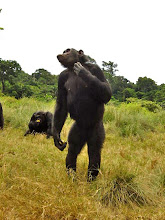”The natives were jovial, courteous and humane.”
In 1741, Carl Linnæus visited Gotland:
In 1741, Carl Linnæus visited Gotland:

Carl von Linné
 Yesterday, I had a chance to enter a very old house, situated on my neighbour´s grounds close to their beautiful Gotland farm at Nygranne, Gotland.
Yesterday, I had a chance to enter a very old house, situated on my neighbour´s grounds close to their beautiful Gotland farm at Nygranne, Gotland. No one really knows when it was built but a guess is during the end of the 17th century. Very few interventions have been undertaken as to resturation measures - proving the quality of the materials and the methods of the old days..
No one really knows when it was built but a guess is during the end of the 17th century. Very few interventions have been undertaken as to resturation measures - proving the quality of the materials and the methods of the old days.. Layers uopn layers of old wallpapers depicts the trends (and economy) through the years....
Layers uopn layers of old wallpapers depicts the trends (and economy) through the years.... The building used to house an inn with lodgings a sort of half-way-hostel 1,5 kms from Visby for travellers heading towards Gotland´s northern coast.

 The surroundings..
The surroundings..Now, one of the historically interesting parts around this old inn is that Carl von Linné - the Swedish botanist, physician, and zoologist, who laid the foundations for the modern scheme of binomial nomenclature - once made a stop here for the night. He was en route on his famous botanical trip to northern Gotland. And he spent the night here on the upper floor of this building. And most probably some food and a "Gotlandsdricku" (see video below on the traditional brewing in Gotland. Swedish only) in the tavern downstairs..
 Carl von Linné, Alexander Roslin, 1775.
Carl von Linné, Alexander Roslin, 1775.Oil painting in the portrait collection at
Gripsholm Castle.
Carl von Linné is known as the father of modern taxonomy, and is also considered one of the father of modern ecology. It is said that he was dead tired upon arrival after having spent some 14 hours on horseback from Visby; the principal town of Gotland.
Actually, he spent some time by my garden too. There is a sign by my fence about his explorations here of the impressive biodiversity of this area.
(The one I´m priviledged to enjoy every day - especially now in the month of May!)
More on Carl von Linné..
God Grief how complicated!
In May 1741, ten days after he was appointed Professor, he undertook an expedition to the island provinces of Öland and Gotland with six students from the university, to look for plants useful in medicine. First, they travelled to Öland and stayed there until 21 June, when they sailed to Visby in Gotland. Linnaeus and the students stayed on Gotland for about a month, and then returned to Uppsala. During this expedition, they found 100 previously unrecorded plants. The observations from the expedition were later published in Öländska och Gothländska Resa,
 written in Swedish. Like Flora Lapponica, it contained both zoological and botanical observations, as well as observations concerning the culture in Öland and Gotland. And finally, as a curiosity: In this book he made a note about the living conditions of Gotland farmers as being:
written in Swedish. Like Flora Lapponica, it contained both zoological and botanical observations, as well as observations concerning the culture in Öland and Gotland. And finally, as a curiosity: In this book he made a note about the living conditions of Gotland farmers as being:
 "Good, orderly and well-arranged".
"Good, orderly and well-arranged".
Actually, he spent some time by my garden too. There is a sign by my fence about his explorations here of the impressive biodiversity of this area.
(The one I´m priviledged to enjoy every day - especially now in the month of May!)
More on Carl von Linné..
God Grief how complicated!
In May 1741, ten days after he was appointed Professor, he undertook an expedition to the island provinces of Öland and Gotland with six students from the university, to look for plants useful in medicine. First, they travelled to Öland and stayed there until 21 June, when they sailed to Visby in Gotland. Linnaeus and the students stayed on Gotland for about a month, and then returned to Uppsala. During this expedition, they found 100 previously unrecorded plants. The observations from the expedition were later published in Öländska och Gothländska Resa,
 written in Swedish. Like Flora Lapponica, it contained both zoological and botanical observations, as well as observations concerning the culture in Öland and Gotland. And finally, as a curiosity: In this book he made a note about the living conditions of Gotland farmers as being:
written in Swedish. Like Flora Lapponica, it contained both zoological and botanical observations, as well as observations concerning the culture in Öland and Gotland. And finally, as a curiosity: In this book he made a note about the living conditions of Gotland farmers as being: "Good, orderly and well-arranged".
"Good, orderly and well-arranged".






































